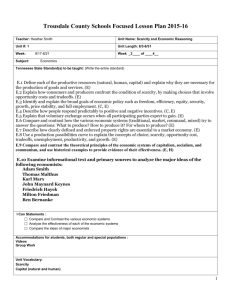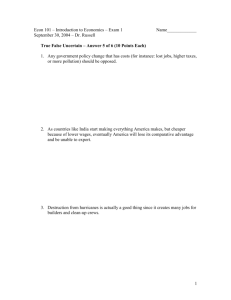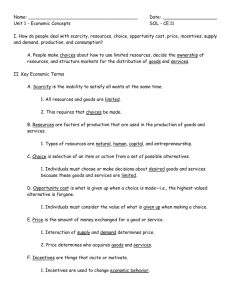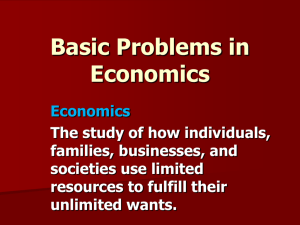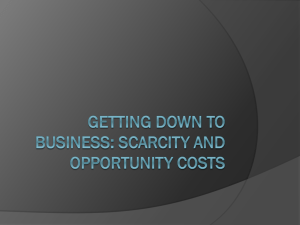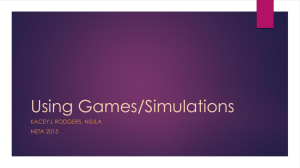Jeopardy Review
advertisement
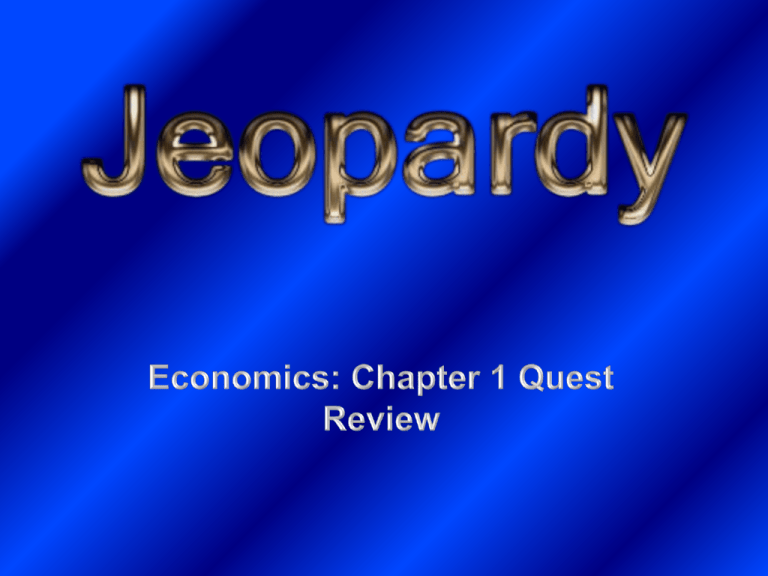
Topic 1 Topic 2 Topic 3 Topic 4 Topic 5 10 10 10 10 10 20 20 20 20 20 30 30 30 30 30 40 40 40 40 40 50 50 50 50 50 QUESTION: •All people have things they wish to have that they hope will bring them satisfaction and happiness. These things are called what? ANSWER: •wants QUESTION: •Who are the three key “players” in economics? ANSWER: •Government, businesses and you. QUESTION: •What is an analogy we might use to compare macroeconomics and microeconomics? Explain why the analogy works. ANSWER: •Macro=the “big picture” of the economy, micro=study of smaller economic units (analogy-forest/tree, microscope/telescope) QUESTION: •What are economists two major goals? ANSWER: •To increase living standards for the long run AND provide stability in the shot run. QUESTION: What would scarcity be represented as in an equation? ANSWER: •Scarcity = Wants > Resources QUESTION: •Describe the difference between tangible and intangible goods and provide three examples of each. ANSWER: •A tangible good can be touched and felt, and an intangible good cannot be touched. Examples vary. QUESTION: •What is a rationing device? Provide an example ANSWER: •A means for deciding who gets what portion of the available resources. Ex. Price. Things are rationed out to those who are willing and able to pay. QUESTION: Economics is the study of ___________________________. ANSWER: •Economics is the study of how we use our limited resources. QUESTION: What is an opportunity cost? And, what is one example of an opportunity cost? ANSWER: •Each time you must make a choice, the result or consequence is called an opportunity cost. It is the alternative you gave up. Examples vary. QUESTION: •What are the Economic Ways of thinking? List and describe 5. ANSWER: •Thinking in terms of cost vs benefit, thinking in terms of trade off, thinking in terms of global economy, thinking in terms of big and small, thinking in terms of what could have been, thinking in terms of unintended effects QUESTION: •What are the two types of economic systems called? And what is it called when a system has elements of both? ANSWER: •Free enterprise and socialism. Both = mixed economy QUESTION: •If you attend a public high school instead of a private school, there is no tuition. Does this mean that there is no opportunity cost for attending school? Explain. ANSWER: •The opportunity cost of attending school is what one would be doing if they did not attend high school. Opportunity costs do exist even if tuition does not (not always linked to $) QUESTION: •In what ways can economic health be “contagious” globally? ANSWER: •Answers vary. Relate to what it means for an economy to be “healthy” QUESTION: •What are the four factors of production? Describe each briefly. ANSWER: •Land-natural resources, labor-physical and mental services, capital-produced goods used as resources for further production, entrepreneurship- special talent for taking advantage of future business opportunities QUESTION: •If most economies of the world are mixed economies, does it follow that most economies are the same? Explain your answer with evidence + an example highlighting your point. ANSWER: •No, they differ as to the degree of free enterprise and socialist features in them One economy might be closer to the socialist end (ex. China) while another might be closer to free enterprise (the U.S.) yet both are mixed economies. QUESTION: •Resources are also called ___________________. ANSWER: •Factors of production QUESTION: •What is perhaps the biggest indicator of a “healthy” economy? ANSWER: •If people/consumers are buying goods and services. QUESTION: Payment to a land resource= _____________ Payment to labor= _________________ Payment to capital= __________________ Payment to entrepreneurship=___________________ ANSWER: •Rent, wages, interest, profits QUESTION: •What are three differences between a free enterprise and socialist economic system? ANSWER: •Gov’t role (FE=small role, S= major role), Eonomic Plan (FE= none, S= written by gov’t leaders), Income distribution (FE=Gov’t pays little attention to equality or inequality of income distribution, S= Gov’t pays much attention to it), Controlling prices FE= prices may fluctuate, S=controls) QUESTION: •What are two specific things a macroeconomist might study AND two specific things a microeconomist might study? ANSWER: •Macroeconomist: study unemployment trends in a country, study the buying behavior of consumers in regards to all goods. •Microeconomists: study unemployment in a particular industry, buying behavior of consumers of a single product QUESTION: •Because scarcity exists, people must make choices. Explain why. ANSWER: •Scarcity is the condition where our wants are greater than the resources available to satisfy those wants. Because we can’t satisfy all our wants, we must choose which ones to satisfy. QUESTION: •Why do economists build theories? ANSWER: •They build theories to provide answers for seemingly unanswerable economic questions. QUESTION: •How do economists judge whether a theory is good or not? ANSWER: •They evaluate theories not on how they sound or seem right, but on how well they predict the future. A good theory is an accurate predictor of future results. QUESTION: •What questions must a society ask itself in determining it’s economic system? ANSWER: •For whom will the goods be produced? How will the goods be produced? What goods will be produced? QUESTION: •Competition is a consequence of scarcity. True or False. Explain. Relate to rationing device, the definition of scarcity. ANSWER: •True. Answers vary.



